Sap Feeders
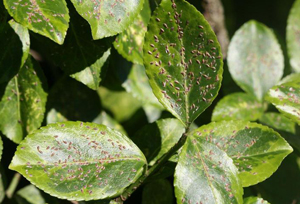
Whitney Cranshaw, Colorado State University, Bugwood.org
Euonymus scale is the most common and most serious pest found on euonymus. It is an armored scale that feeds on euonymus and several other species (holly, honeysuckle, lilac, etc.). Infestation can cause yellowing, dieback, and death of infested plants. Males have a white cover with three longitudinal stripes; they are usually found on leaves and branches. Females have a dark cover, often described as shaped like an oyster shell; they occur on the stems of plants. Crawlers are tiny (pin-head size), yellow, and, unlike the adults, are mobile to find new sites to infest. Crawlers are the easiest stage to control and are active in May and July.
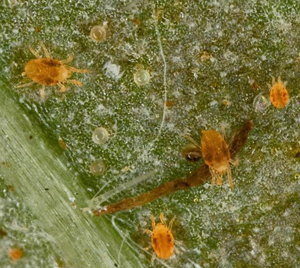
David Cappaert, Bugwood.org
Two-spotted spider mites are pests of numerous species of plants, causing damage by sucking juices from foliage resulting in stippling. If populations are high enough leaves may appear chlorotic and there can even be leaf drop. Silk webbing may also be present in high populations. Mites themselves are hard to see; they are 1/50 inch long and are pale green to yellow . They have two prominent spots that give them their name. Damage may start appearing in June. One can confirm the presence of mites by knocking a branch held over a piece of white paper and watching for movement.
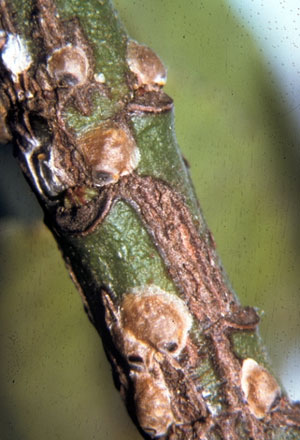
United States National Collection of Scale Insects Photographs , USDA Agricultural Research Service, Bugwood.org
Greedy scale are small armored scales that create a conical shaped cover. As they grow and shed their old exoskeleton, it is incorporated into the wax that makes up the shield. Eventually this results in a characteristic off-center nipple or dot on the outer coating. There are often concurrent overlapping generations on plants
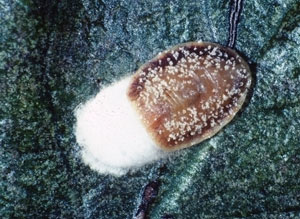
John A. Davidson, Univ. Md, College Pk, Bugwood.org
Cottony camellia scale adult females are about 1/8 inch long but they produce long white egg masses behind them, so they appear much larger. These egg masses are laid on the undersides of leaves and crawlers will hatch and feed throughout the summer. Their feeding results in large quantities of honeydew, which in turn leads to development of black sooty mold.
Root Feeders
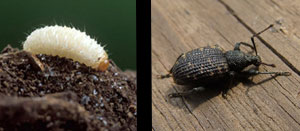
grub: Peggy Greb, USDA Agricultural Research Service, Bugwood.org ;
adult: Cheryl Moorehead, Bugwood.org
Black vine weevil grubs are white legless larvae with yellow brown or red heads that live in the soil and feed on plant roots. Moderate root feeding may cause plants to show signs of drought stress. Girdling can occur and nutrient transmission is disrupted, occasionally leading to death of the plant. The adults (0.5 inch long) are dark snout beetles that may chew crescent-shaped holes in leaves while feeding at night. Normally there is one generation per year with the larva overwintering. Pupation and adult emergence occurs in the spring. Sometimes adults may overwinter which can result in damage occurring from larvae earlier in the season.